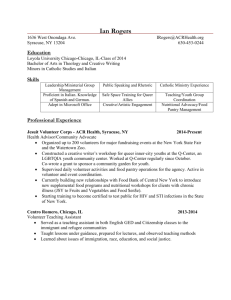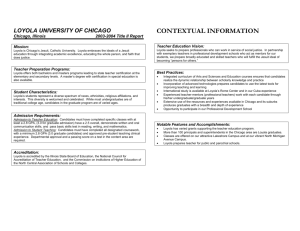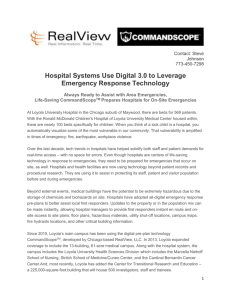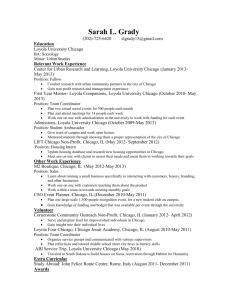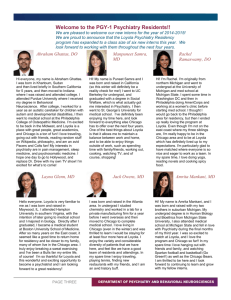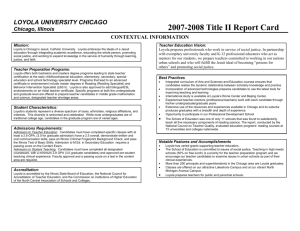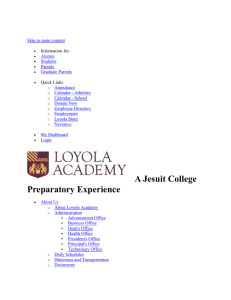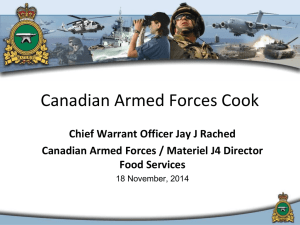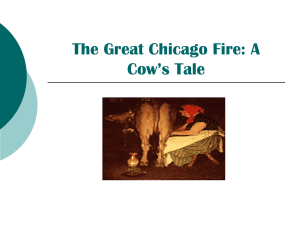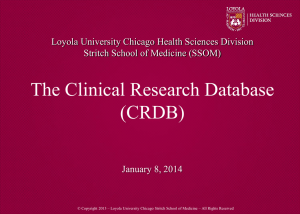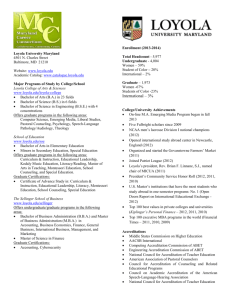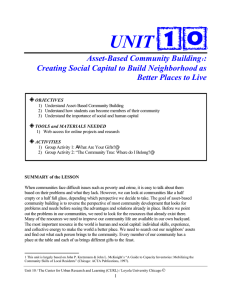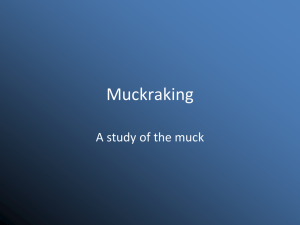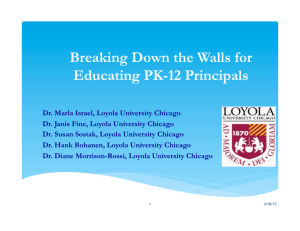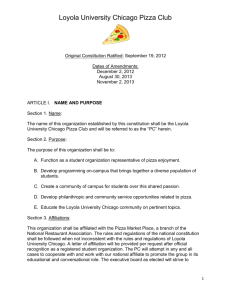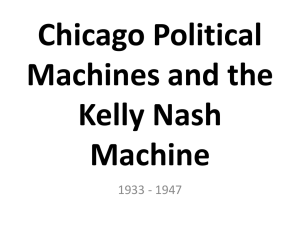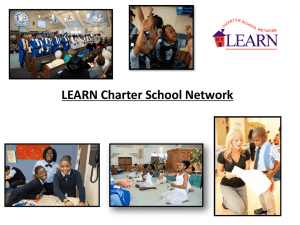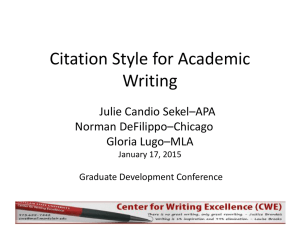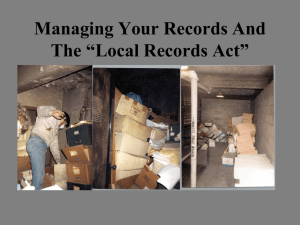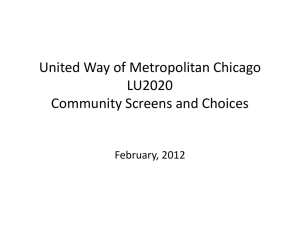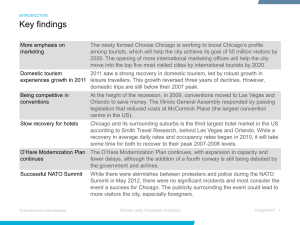Presentation 1 - National Healthy Homes Conference
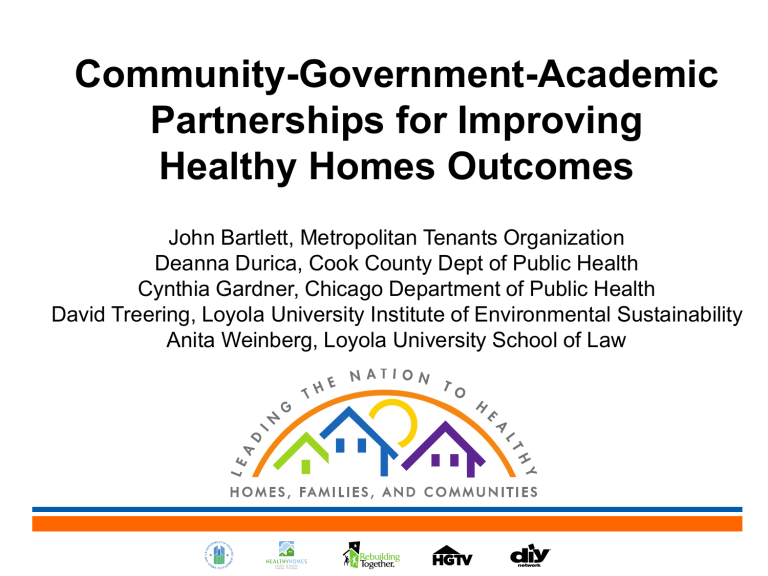
Community-Government-Academic
Partnerships for Improving
Healthy Homes Outcomes
John Bartlett, Metropolitan Tenants Organization
Deanna Durica, Cook County Dept of Public Health
Cynthia Gardner, Chicago Department of Public Health
David Treering, Loyola University Institute of Environmental Sustainability
Anita Weinberg, Loyola University School of Law
Who we Are
:
• Metropolitan Tenants Organization
• Community-based organization
• Mission - educate, organize and empower tenants
• Served 15,000 individuals annually
• Chicago Department of Public Health
– CDPH is the state certified public health agency for Chicago
– Serves 2.7m residents
• Cook County Department of Public Health
– CCDPH is the state certified public health agency for suburban Cook
County, Illinois (excludes Chicago)
– One of the seven affiliates of the Cook County Health and Hospitals System
– Serves approximately 2.5 million residents
– 129 municipalities
• Loyola University Chicago
– Education and Service
– Centers of Excellence
Background
• Lead Safe Housing Task Force (1997)
– Housed, chaired, staffed by Loyola Civitas ChildLaw Center
– Mission: to develop and implement workable strategies to eliminate childhood lead poisoning
• Advocate for policy reform
• Promote public awareness
• Foster collaborations to achieve mission
• Strategic planning
• Community activities
• Raising awareness/education
• Legislative advocacy
• Research
Lessons Learned Working in Partnership
• Take the time to establish trust
• Build on strengths of partners
• Patience – change takes time
• Compromise – but carefully
Advancing Healthy Homes/Healthy
Communities Initiative
Initial steps
– 2010: group of faculty researchers brainstormed and discussed the impact of environmental toxins in our homes and communities.
– Affiliated faculty from CUERP, CURL, CHRC, and the Civitas
ChildLaw Center developed a Concept Paper
– 2011: received University Strategic Planning grant to develop an interdisciplinary initiative to address these toxins and related issues
Developed Intra-univ. Advisory Council to garner interest
– Representatives from University Centers, Schools of Medicine,
Nursing and Law, Departments of Political Science, Psychology
Established External Advisory Group
– Including representatives from University, communities, City,
County, federal government
• Identified research agenda based on universitycommunity-government interests and needs
Flow Chart of Partnership Activities
University as Partner
Partnership benefits – to University as partner
• Applied research
– More effective in concert than each alone
• Experiential learning opportunities for students
• Community engagement
– Local knowledge
• Expertise and skills of partners
– Politics
Partnership benefits – of University as partner
• Collaborations
– Intra-university, cross discipline scholars and groups
– Faculty, staff and students
• Approach and Expertise
– Interdisciplinary research
– Using theory and framing problems
– Adding an objective perspective to what partners know
– Evidence based approach to data collection and analysis
• Resources
– Physical space for convening group meetings
– Software and expertise for analysis
– Law school clinics
– Communications and Marketing programs
– Network of Contacts
Challenges –
for
University as partner
• Building partnerships
– Intra-university
• Research priorities, time, location
– Stakeholders external to university
• Building trusting relationships
• Priorities
– Competing with other important priorities
• Funding
– Research and outreach
– Interventions and solutions
• Messaging
– Terminology and a common language
– Relevance vis a vis competing priorities
– Overload of information
Community as Partner
Be clear on expectations about the partnership
Partnership benefits – to community partners
• Resources
– financial from partnership grants
– research and evaluation
• Relationships
– University can bring together diverse groups – government, other stakeholders, opponents in nonpartisan manner
• Help with developing new programs
• Advocacy to get policies and laws passed
• Opportunity for community partners to raise awareness/tell their stories/teach others about community and issues experienced
• Opportunity for community partners to engage younger generation (students) on issues they care about
Community as Partner
Partnership benefits – of community partners
• Real life experiences of people impacted by issues
• With the experiences they also bring an analysis of whether solutions/policies will work
• Bring relationships with other community based organizations to partnership
• Bring credibility to public entities and University
• Help identify problems/issues raised needing to be addressed and/or researched
Community as Partner (cont)
Challenges –
for
Community Partners
• Watch the use of acronyms and other language
• Experts can be intimidating for community people
• Making sure all voices are heard
• Setting goals and priorities that all parties can agree to and then making sure that progress is made on the issue
• Organize communication with community members
Public Entities as Partner
Partnership benefits to public entity partners
• Leverage existing partnerships that might not have been yours
– Builds relationships
– Builds credibility
– Builds evidence
Partnership Entities as Partners
Partnership benefits to public entity partners
• Increased capacity to get things done
– Limited resources and staff capacity are enhanced when we’re all sharing pieces of the work
• Motivational force
– The bully pulpit
– External pressure =
• Support when aligned with agency priorities,
• A “kick in the pants” when priorities are lagging behind
Public Entities as Partner
Partnership benefits of public entity partners
• Provides in-roads to decision makers that might not otherwise be available
– Builds relationships
– Builds credibility
• Increased capacity to get things done
– Access to data
– Access to people
– Access to “insider” information
• Policy enforcement
Challenges -
for
Public Entities as Partners
• Politics
– What can I say? When can I say it? Is the president’s office on board?
• Buy-in
– Getting support of the leadership making funding decisions
• Deliverables
– Not overpromising, not under-performing
• Value
One Partnership Initiative:
City/Countywide Working Summit, June 2014
• Invitational working conference on Healthy
Homes/Healthy Communities in coordination with
Chicago and Cook County Departments of Public Health
• Goal: Host a regional working conference to identify and prioritize policy priorities for developing a city-countywide strategic plan to tackle the burden of unhealthy housing
• Target Audiences
– Policy makers: City, County, State and Federal agency staff from
Housing, Environmental Protection, Public Health
– Academic peers: Chicagoland institutions
– Non-Profits and NGOs: Environmental sustainability and
Community health organizations
City/Countywide Working Summit, June 2014
• Working Group Topics
– Public health and social service interventions
– Raising awareness among decision makers
– Reviewing and evaluating existing regulations, laws and policies around healthy homes; identifying future approaches
– Sustainable solutions
Thank you!
John Bartlett, Metropolitan Tenants Organization
Johnb@tenants-rights.org
Deanna Durica, Cook County Dept of Public Health ddurica@cookcountyhhs.org
Cynthia Gardner, Chicago Department of Public Health cynthia.gardner@cityofchicago.org
David Treering, Loyola Inst of Environmental Sustainability dgolb2@luc.edu
Anita Weinberg, Loyola School of Law aweinbe@luc.edu
